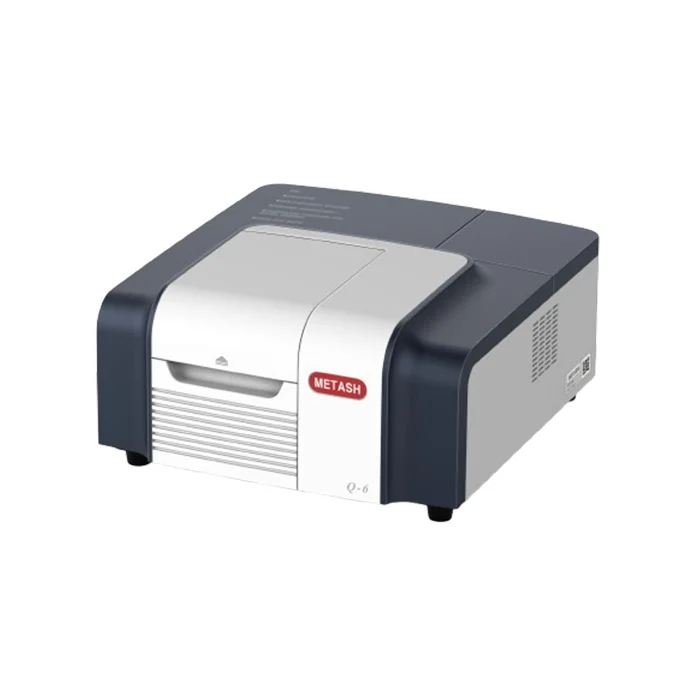- This topic is empty.
-
AuthorPosts
-
2025-04-23 at 5:31 pm #9356
The detection of heavy metals in environmental, industrial, pharmaceutical, and biological samples is of paramount importance due to the toxicological implications even at trace levels. Among the numerous analytical techniques available, UV-Visible spectrophotometry remains a widely used and reliable method due to its cost-effectiveness, ease of use, and reasonable sensitivity. In this blog post, METASH, as precision benchtop UV vis spectrophotometer exporter, will share the role of double beam UV visible spectrophotometer in heavy metal detection.
Understanding Double Beam Configuration
In a double beam UV-Visible spectrophotometer, the light source is split into two beams: one passes through the sample, and the other through a reference (blank or solvent). Both beams are directed to separate or alternating detectors. This configuration compensates for fluctuations in the light source and detector response, resulting in enhanced accuracy, stability, and baseline correction.
Key components include:
– Light Source: Typically a deuterium lamp (UV region) and tungsten-halogen lamp (visible region).
– Monochromator: Selects specific wavelengths using diffraction gratings or prisms.
– Beam Splitter: Divides light into sample and reference beams.
– Sample and Reference Compartments: CUVettes containing the analyte and blank respectively.
– Detectors: Photodiodes or photomultiplier tubes detect transmitted light.
– Data System: Converts detector signals to absorbance and provides spectral data.

Role of Double Beam UV Visible Spectrophotometer in Heavy Metal Detection
1. Indirect Detection via Complex Formation
Most heavy metals, including lead (Pb²⁺), mercury (Hg²⁺), cadmium (Cd²⁺), arsenic (As³⁺/As⁵⁺), and chromium (Cr³⁺/Cr⁶⁺), do not exhibit strong UV-Vis absorbance on their own. To enable spectrophotometric analysis, they are reacted with specific ligands to form colored complexes. For instance:
– Dithizone for Pb²⁺ and Hg²⁺ (forms pink to red complexes).
– Eriochrome Black T or PAR (4-(2-pyridylazo)resorcinol) for Ni²⁺, Co²⁺.
– Diphenylcarbazide for Cr⁶⁺ (forms a violet complex at ~540 nm).
– EDTA-metal complexes (though often colorless, can be visualized with indicators).
The double beam spectrophotometer accurately measures the absorbance of these complexes against a reference, minimizing errors due to solvent, cUVette imperfections, or instrumental drift.
2. Improved Sensitivity and Accuracy
The double beam design enhances the signal-to-noise ratio, allowing the detection of metal ions at trace levels (ppb to ppm range). This is especially critical in environmental monitoring where regulatory limits for heavy metals are extremely low.
– Continuous comparison with the reference beam allows real-time correction of baseline shifts.
– Fluctuations in lamp intensity or detector sensitivity are automatically normalized.
– High stability enables accurate kinetic studies for time-dependent reactions or slow complexation processes.
3. Quantitative Analysis through Calibration
For quantitative detection, standard calibration curves are developed using known concentrations of metal-ligand complexes. The absorbance of unknown samples is interpolated on this curve.
– Linearity of response is crucial, and double beam systems maintain consistent linearity across a wide concentration range.
– Multicomponent analysis is also possible when different metals form complexes absorbing at distinct wavelengths.
4. Multi-Wavelength and Spectral Scanning
Modern double beam spectrophotometers support full spectral scanning, enabling:
– Identification of optimum λmax for maximum sensitivity.
– Assessment of spectral purity to confirm the specificity of the complex formed.
– Simultaneous detection of multiple metals if their complexes have distinct spectral profiles.
For example, a mixture of Cu²⁺ and Ni²⁺ forming blue and green complexes, respectively, can be distinguished and quantified by selecting appropriate wavelengths.
5. Application Versatility
Double beam UV-Vis spectrophotometers are adaptable across a wide range of sample matrices:
– Environmental samples: Detection of Pb²⁺, Cr⁶⁺, and As³⁺ in water and soil extracts.
– Industrial effluents: Monitoring heavy metals in electroplating waste, mining runoff.
– Pharmaceuticals: Trace metal analysis in drug formulations for compliance with pharmacopeial limits.
– Food and biological samples: Assessment of toxic metals in dietary supplements, blood, or urine (often after acid digestion or chelation extraction).
Advantages Over Single Beam System
Feature
Double Beam
Single Beam
Light Source Fluctuation
Compensated in real-time
May introduce errors
Baseline Correction
Automatic via reference beam
Manual blanking required
Accuracy and Reproducibility
High
Moderate
Suitable for Kinetic Studies
Yes (continuous reference comparison)
Limited
Long-term Stability
Excellent
Susceptible to drift
Cost
Higher initial cost
Lower
The higher cost of double beam systems is offset by improved reliability, making them ideal for routine and research-grade heavy metal analysis.
Conclusion
The double beam UV-Visible spectrophotometer plays a pivotal role in the detection and quantification of heavy metals, offering a blend of sensitivity, reliability, and user-friendliness. By leveraging ligand-based colorimetric methods, it transforms otherwise UV-invisible metal ions into measurable entities. Its superior design ensures precise absorbance measurements, even under variable operating conditions, making it an indispensable tool in environmental monitoring, industrial quality control, and public health protection. As advancements in automation and software integration continue, the double beam UV-Vis spectrophotometer is poised to remain a cornerstone in the analytical chemistry arsenal.
http://www.metashcorp.com
Metash -
AuthorPosts
- You must be logged in to reply to this topic.